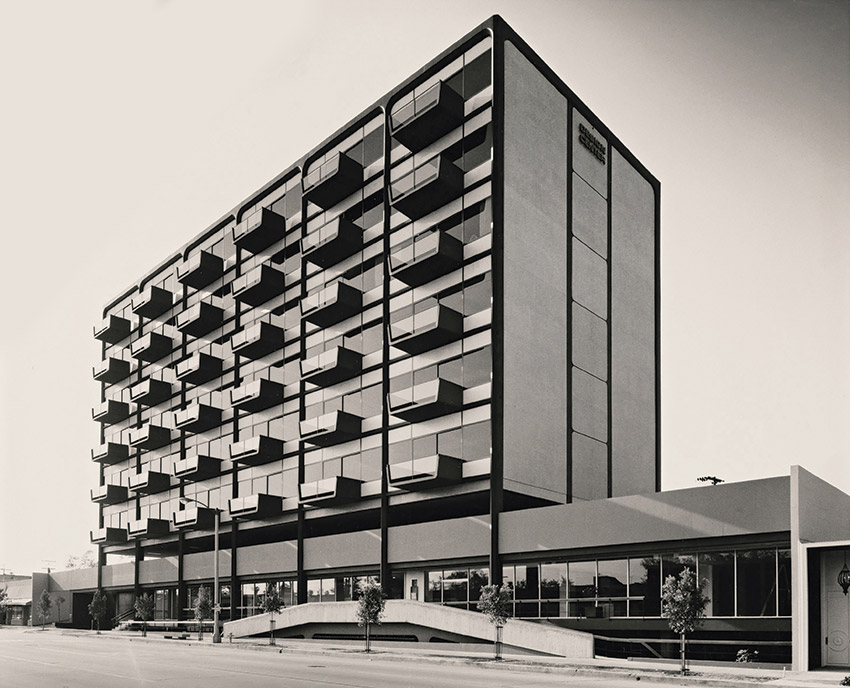
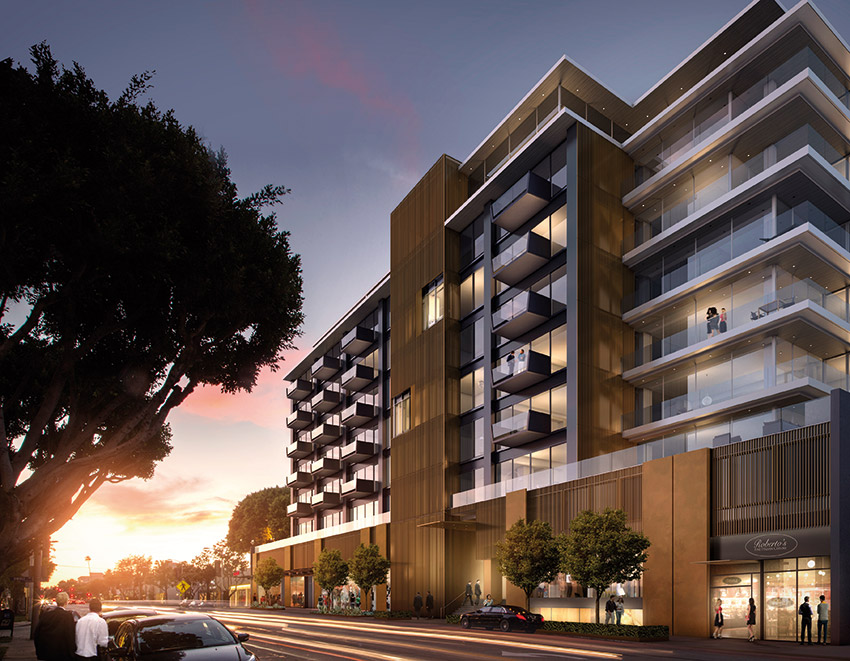
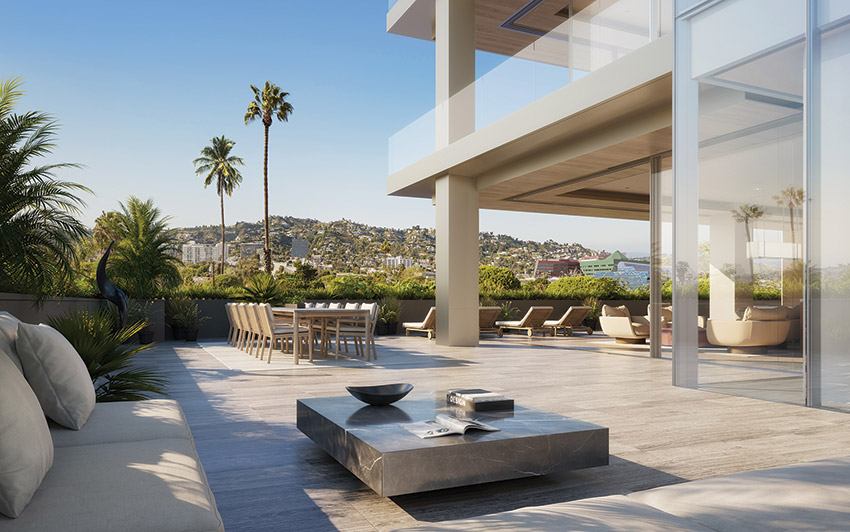
Julius Shulman, J. Paul Getty trust, Getty Research Institute, Los Angeles, 2004.r.10 (first); © Binyan Studios; VisualHouse (second)
The former Los Angeles International Design Center (first), a 1960s building, is being expanded by Olson Kundig to create a 40-unit condominium (second and third).
Among the many aspects of daily life that the pandemic has transformed, perhaps irreversibly, is the expectation that corporate office work takes place in a corporate office. More than a year of widespread working from home has shown just how adaptable workers and work itself can be. It turns out people can get a great deal done from a corner of their living room, their kitchen table, or—oh! luxury—an actual home office with an actual door, all while being more present for their family and personal projects, not to mention the laundry.
Recent analysis by McKinsey Global Institute suggests that more than 20 percent of the workforce could work remotely three to five days a week just as effectively as from an office—that’s three to four times prepandemic levels. Major companies, including Amazon, Capital One, Facebook, and Ford, have announced permanent remote-work options for eligible staff. Office-vacancy rates have hit new highs—around 19 percent in Manhattan, 22 percent in Chicago, and 24 percent in Los Angeles, with office space available for sublease nationwide up 40 percent at the end of 2020 over the year before. Most affected are older, less desirable buildings as tenants migrate to higher-quality premises. With some experts predicting that vacancy rates will continue rising through 2022, the implications for commercial real estate are profound. So are the possible knock-on effects for municipal tax revenues, transportation, retail, and the vitality of urban centers. It’s no surprise that pundits are pondering whether converting surplus office space to housing can help.
When the pandemic started shutting down projects in Gensler’s corporate workplace practice, the firm asked building-owner clients if there was something that would be helpful in the interim. “We honestly thought they were going to ask us to design some stickers on the floor to keep people apart,” says Steven Paynter, a principal and regional practice area leader for office buildings at Gensler. “Instead, they asked us to help them regain some confidence in their real-estate portfolios.” Clients in the Canadian oil industry center of Calgary, Alberta, were especially concerned. With pandemic-related vacancies compounding effects of the 2015 energy-sector crash and this year’s cancellation of the Keystone Pipeline, Calgary’s downtown office-vacancy rate is hovering around 32 percent. That translates to an astronomical 12 million square feet of empty real estate. “They realized they weren’t going to see it bounce back,” Paynter says. “They really needed to do something.”
Starting with a single client’s portfolio, and then rapidly expanding at the request of Calgary Economic Development to include more than half of the downtown core, Gensler’s Toronto studio developed a system for scoring office buildings’ suitability for conversion to housing as, Paynter says, a data-based way out of decision paralysis.



Julius Shulman, J. Paul Getty trust, Getty Research Institute, Los Angeles, 2004.r.10 (first); © Binyan Studios; VisualHouse (second)
The former Los Angeles International Design Center (first), a 1960s building, is being expanded by Olson Kundig to create a 40-unit condominium (second and third).
Among the many aspects of daily life that the pandemic has transformed, perhaps irreversibly, is the expectation that corporate office work takes place in a corporate office. More than a year of widespread working from home has shown just how adaptable workers and work itself can be. It turns out people can get a great deal done from a corner of their living room, their kitchen table, or—oh! luxury—an actual home office with an actual door, all while being more present for their family and personal projects, not to mention the laundry.
Recent analysis by McKinsey Global Institute suggests that more than 20 percent of the workforce could work remotely three to five days a week just as effectively as from an office—that’s three to four times prepandemic levels. Major companies, including Amazon, Capital One, Facebook, and Ford, have announced permanent remote-work options for eligible staff. Office-vacancy rates have hit new highs—around 19 percent in Manhattan, 22 percent in Chicago, and 24 percent in Los Angeles, with office space available for sublease nationwide up 40 percent at the end of 2020 over the year before. Most affected are older, less desirable buildings as tenants migrate to higher-quality premises. With some experts predicting that vacancy rates will continue rising through 2022, the implications for commercial real estate are profound. So are the possible knock-on effects for municipal tax revenues, transportation, retail, and the vitality of urban centers. It’s no surprise that pundits are pondering whether converting surplus office space to housing can help.
When the pandemic started shutting down projects in Gensler’s corporate workplace practice, the firm asked building-owner clients if there was something that would be helpful in the interim. “We honestly thought they were going to ask us to design some stickers on the floor to keep people apart,” says Steven Paynter, a principal and regional practice area leader for office buildings at Gensler. “Instead, they asked us to help them regain some confidence in their real-estate portfolios.” Clients in the Canadian oil industry center of Calgary, Alberta, were especially concerned. With pandemic-related vacancies compounding effects of the 2015 energy-sector crash and this year’s cancellation of the Keystone Pipeline, Calgary’s downtown office-vacancy rate is hovering around 32 percent. That translates to an astronomical 12 million square feet of empty real estate. “They realized they weren’t going to see it bounce back,” Paynter says. “They really needed to do something.”
Starting with a single client’s portfolio, and then rapidly expanding at the request of Calgary Economic Development to include more than half of the downtown core, Gensler’s Toronto studio developed a system for scoring office buildings’ suitability for conversion to housing as, Paynter says, a data-based way out of decision paralysis.
Drawing on consultations with 56 cities internationally as well as its own in-house research, Gensler created an algorithm that uses readily available data to compare an office building with best-in-class residential buildings. The algorithm runs over 50 variations for each building, tabulates its percentage of similarity to top-performing residential developments, and displays the results in a user-friendly dashboard format. It then tests the top picks, accounting for typical net-to-gross ratios, allocating average unit sizes based on location, estimating numbers of units to a building, and calculating how many elevators and what size service risers are required. “And it’s doing that in about five minutes,” says Paynter. “It’s allowed us to do half of Calgary in two weeks.” The speed of the analysis, along with $160 million from the City of Calgary in downtown revitalization funding (of which $36 million is earmarked specifically for this type of repositioning) has so far enabled about a dozen conversions to get under way.
Key factors the algorithm assesses include the building’s context, with maximum points going to buildings with cultural or heritage value that are located in mixed-use neighborhoods with access to green space, amenities, and transit. Building form also matters, with orthogonal shapes preferred. Among site-related factors, buildings on corner lots having at least 65 feet to adjacent mid- or high-rise neighbors have an advantage. Windows are ideally located on at least three sides, with extra points for south-facing glazing that covers at least 40 percent of the wall area. Floor plates with a minimum 40-foot depth, 8,000-square-foot area, and 9-foot floor-to-floor height, served by multiple elevators, earn top marks. Structure and servicing, ease of required upgrades, and adequate parking garner additional points.
A redevelopment completing construction this fall in Los Angeles, designed by Olson Kundig Architects with Large Architecture, ticks many of those boxes. Originally designed by Midcentury Modern architect Richard Dorman and built in 1964 as the Los Angeles International Design Center, the 10-story 8899 Beverly Boulevard is the tallest building in its dynamic, increasingly walkable neighborhood. Its conversion will create 40 condominium units, with eight new townhouses as a separate structure. “This type of project is the future of development in dense urban-infill areas, where undeveloped land is virtually nonexistent,” says Tyler Siegel, cofounder of Townscape Partners, the conversion’s developer. “And, in some respects, it represents the ultimate sustainable project, in that the entire building is recycled.”
Along with the building’s location, where the city has created incentives to boost residential and mixed-use development, factors such as the mid-rise height, generous floor-to-floor spans (by residential standards), views, and even balconies made what Siegel calls the perfect starting point.
From a design perspective, “the biggest challenge was also the most exciting,” says Tom Kundig, design principal: “how to maintain the integrity of the original Dorman building, but tie it in with a new function as a residential building.” The redevelopment expands the building footprint to 17,000 square feet (from a minimally viable 8,500) “while keeping the form of the original building legible, creating a dialogue between old and new,” Kundig says. Ribbon windows have been replaced with floor-to-ceiling triple glazing, much of it operable, with minimized frames and continuous flooring enhancing continuity between unit interiors and the balconies, terraces, and views beyond. Interior details, such as Kundig-designed leather-wrapped bronze door handles, honor the building’s historic association with design and its location in a design-branded district.
Working with an existing building often presents unique hurdles. In this case, the most significant was an extensive structural upgrade to meet current building codes—a necessity triggered by the building’s change of use. New 2-foot-thick concrete shear walls and column-reinforcing concrete wrap achieved current seismic standards. The decision to expand the floor plates with post-tensioned concrete slabs and new supporting columns, and to add a penthouse with a cantilevered steel structure, necessitated a new 5-foot-thick mat foundation beneath the entire building. Meeting design tolerances and resolving the junctions of old and new took painstaking attention to detail throughout. “Difficulty level 10,” says Siegel, pointing to a 1⁄2-inch base reveal for the glazing track, which required the old and new slab elevations to marry perfectly, as just one example.
Despite those difficulties, the renovation is achieving multiple values: giving a distinctive building (and its embodied resources) a new lease on life, darning a hole in the city’s fabric, and helping a neighborhood evolve. “This project presented an opportunity to reimagine an existing midcentury building for a changing urban landscape,” says Kundig. “I’m interested in architecture that tells an evolutionary story—reflecting changes in how we live, and how we plan cities.”
The reference to an evolutionary story is a useful reminder: although pandemic-related vacancies and the buzz around conversions may suggest that a real-estate revolution is under way, adapting workplaces to housing is in fact nothing new. Nineteenth-century warehouses and manufacturing facilities have become coveted lofts. Daylit and naturally ventilated office buildings from the early 20th century have become desirable apartments. In most cities, these building types have now been largely converted, and office buildings from the second half of the 20th century are cycling in. “With existing buildings, you’re mining whatever stock is there,” says John Cetra, a principal at New York–based CetraRuddy Architecture, a firm that has completed some 4 million square feet of commercial-to-residential renovations in its 30 years of practice.
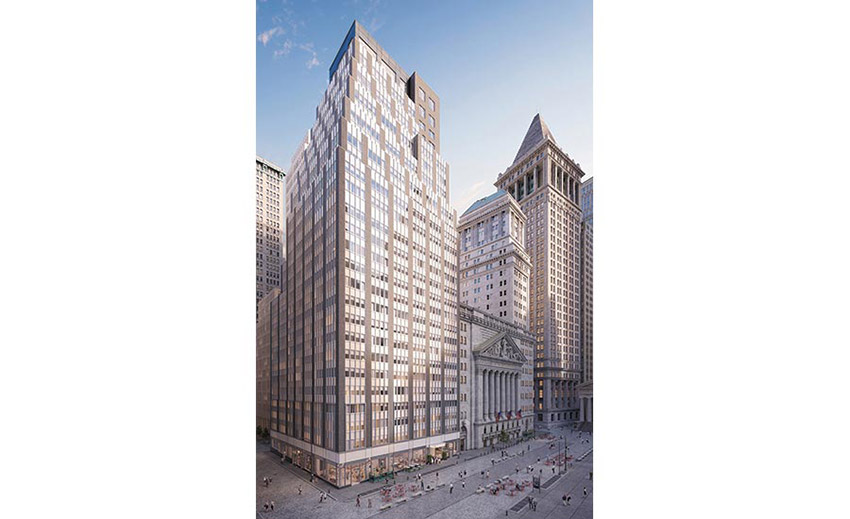
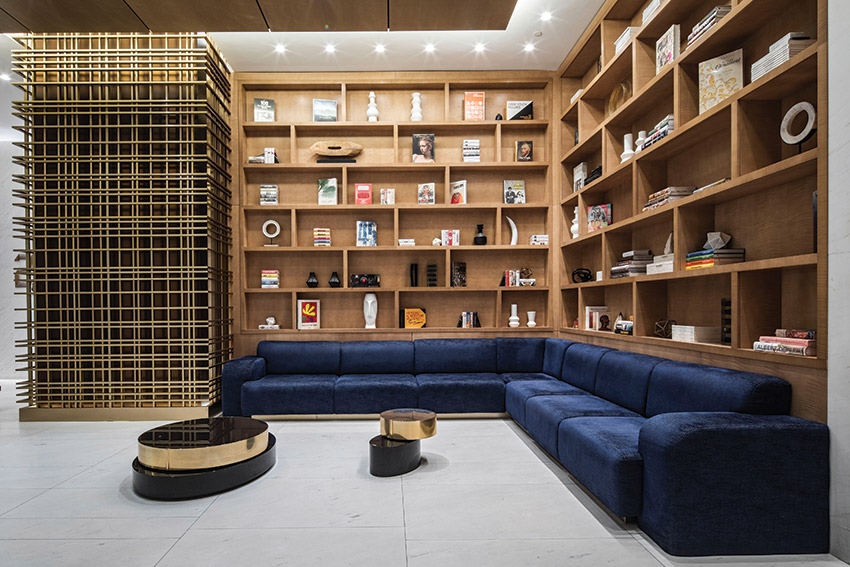
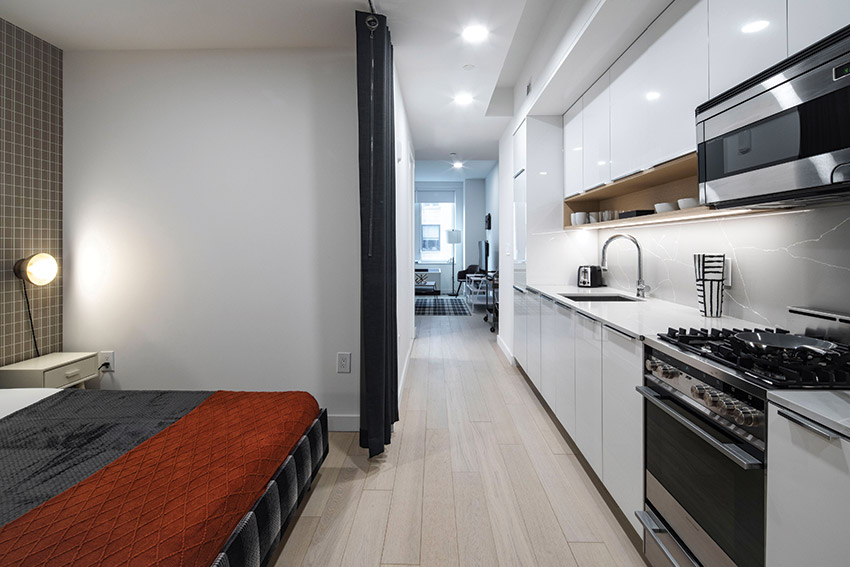
Courtesy Cetraruddy; © Katherine Marks
In lower Manhattan, CetraRuddy has converted a midcentury office tower into a rental apartment building (first), warming up the lobby with domestic touches such as bookshelves (second), and taking advantage of in-unit areas far from windows for sleeping alcoves and kitchens (third).
Buildings from the mid-20th century, with characteristically deep floor plates and a reliance on electrical lighting and mechanical ventilation, present a new set of challenges for adaptive reuse. CetraRuddy’s renovation of 20 Broad Street, built in 1956 as an extension to the New York Stock Exchange and converted into 535 rental apartments in 2020, illustrates some of the problems that are typical in adapting buildings from this period. The 30-story building, whose wedding-cake layers provided scope for prized outdoor terraces, has extremely large floor plates: 20,000 square feet at the base, with 40- to 45-foot lease spans (the distance from the outside wall to the core), compared to the 30-foot spans more typical for residential developments. That means 20 Broad’s interior depths are a long way from daylight, and although New York State’s building code permits dwelling spaces to be mechanically ventilated, bedrooms are still required to have an operable window.
In response, the design activates in-unit corridors with galley kitchens, office/sleeping alcoves, storage closets, and laundry facilities. Space in and around the building’s central elevator core is used for tenant amenities, such as fitness facilities, a children’s playroom, library, game room, and lounge. In addition to spatial and programming solutions, outdated mechanical systems were replaced, as were windows to get them opening again, and a chilly corporate lobby was warmed up with bookshelves, layered lighting, and decorative brass grillwork. “It’s really the creativity you bring to it,” says Cetra. “In residential design, a lot of buildings are very similar on the inside. When you start with a building that has interesting and unique characteristics—volumetric, shape, and setbacks—it’s a lot of fun to work with them.”
All of the units at 20 Broad are market rate, as are those at 8899 Beverly Boulevard. “Unused office buildings in urban environments often seem like great opportunities to create much-needed new affordable housing,” says Cetra, “but it can be difficult to reach the necessary levels of efficiency to make a conversion like this feasible.” Hotels, on the other hand, which typically have very efficient floorplates with shorter lease spans, are much better candidates for conversion to affordable housing, he says.
Philadelphia-based real-estate developer Ron Caplan, president of PMC Property Group, agrees. “There’s no way that I’m aware of for a developer to build low-income housing in a conversion without significant subsidy,” he says, pointing out that most office buildings suitable for conversion are in city centers, with purchase prices that reflect their location. “Creating a high-rise conversion is simply expensive.”
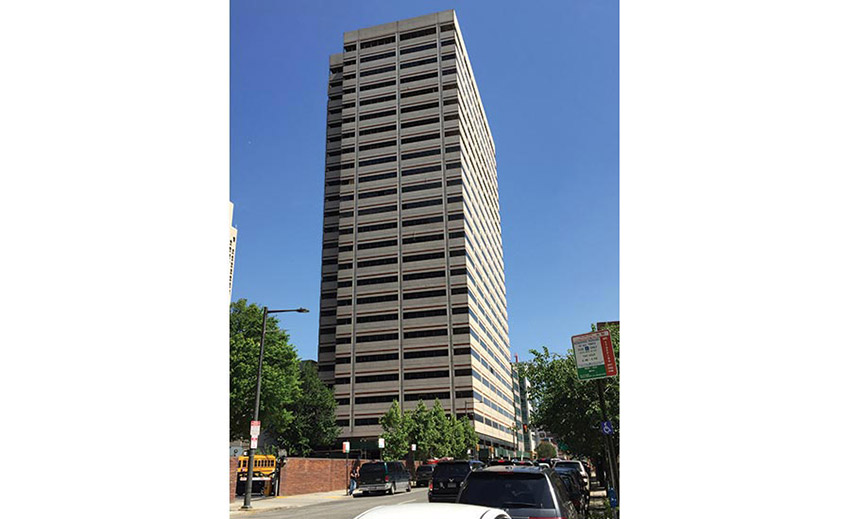
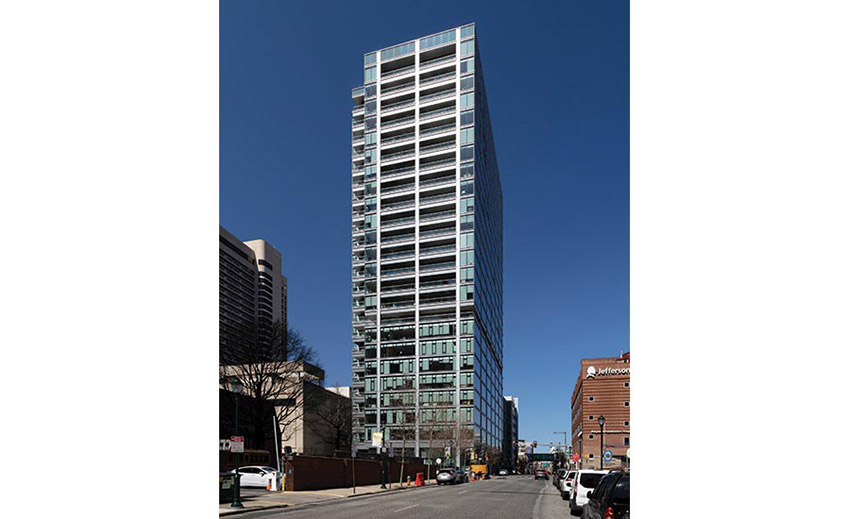
Photography: © Robert Deitchler, courtesy Gensler
A dated 1970s Philadelphia office tower, with a precast facade and strip windows (first), was recently revamped by Gensler and is now a sleek, glass-clad residential building (second).
PMC recently renovated Franklin Tower (completed in 2019), a long-vacant 605,000-square-foot, 24-story office tower that was built in the late 1970s in Philadelphia’s Logan Square neighborhood as part of a hotel complex but subsequently severed to flounder on its own. Its environmental-control systems were no longer viable, its floor plates were inconsistent with contemporary office design, its retail level was recessed at the back of a gloomy arcade, and its facade—precast concrete with strip windows—was just plain repellent. “The issue—and frankly it’s a societal issue—is, what are we going to do with all the office buildings that become outdated over time?” says Caplan.
The conversion, designed by Gensler’s New York office, completely reclad the previously uninsulated structure, replacing 4-foot window openings with full-height double glazing—an improvement in energy performance—and recessing it to create balconies. It brought the retail level out to meet the street, with an indoor basketball court on the corner. And it used core spaces formerly occupied by large double-gang restrooms and utility rooms to provide an array of amenities, including a yoga studio, spinning room, movie lounge, and work spaces (prescient, given what was coming). In addition, there’s a dog park, and a rooftop lounge—complete with fireplace, kitchen, and fitness center, adjacent to an outdoor terrace with another kitchen, a grill, and picnic and lounge seating. “It’s arguably over-amenitized, if that’s possible these days,” says Robert Fuller, a principal at Gensler and the project’s design lead. “There’s a great quote from our client: ‘I want them to rent the apartment before they even see the apartment.’ ”
The strategy was sound: all the building’s 549 units leased in just 16 months. “This was an old dog of a precast relic. It’s now a sought-after property,” says Fuller. “As a firm committed to sustainability, we see this as a great example of trying to do more with what we have rather than knocking it down.”
The adaptive reuse of franklin tower takes place in the context of philadelphia’s successful history of urban revitalization, says paul levy, founding chief executive of the center city district, a business-improvement association that, since its inception in 1991, has helped to catalyze the conversion of about 4.5 million square feet of vacant workplaces in the formerly 9-to-5 downtown. As a measure of the success of these changes, levy compares the impact of recessions on the district’s assessed property value: in the early 1990s, pre-conversion, it fell 26 percent; between 2008 and 2010, it actually rose. “diversification of downtown land use has been absolutely key to the fiscal health of the city,” he says. As for the future of office buildings, levy predicts that workplaces will continue to fulfill a critical function in city centers. Looking back on the historic impacts of pandemics, he says, “you find that cities bounce back in a remarkable way.”
Suplemental Materials
What’s Next for Remote Work: An analysis of 2,000 tasks, 800 jobs, and nine countries. McKinsey Global Institute, November 23, 2020.





















